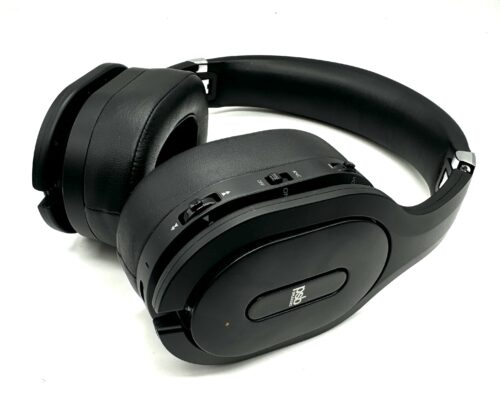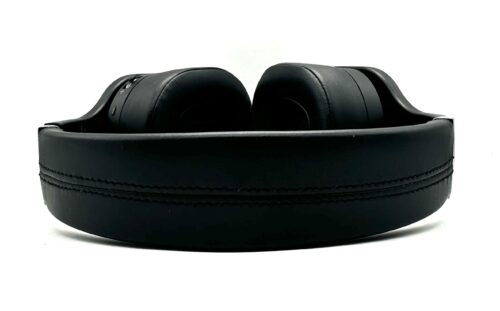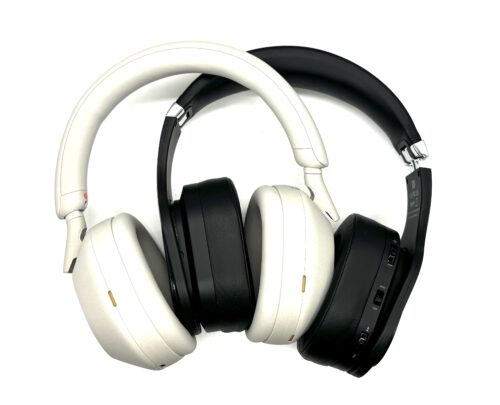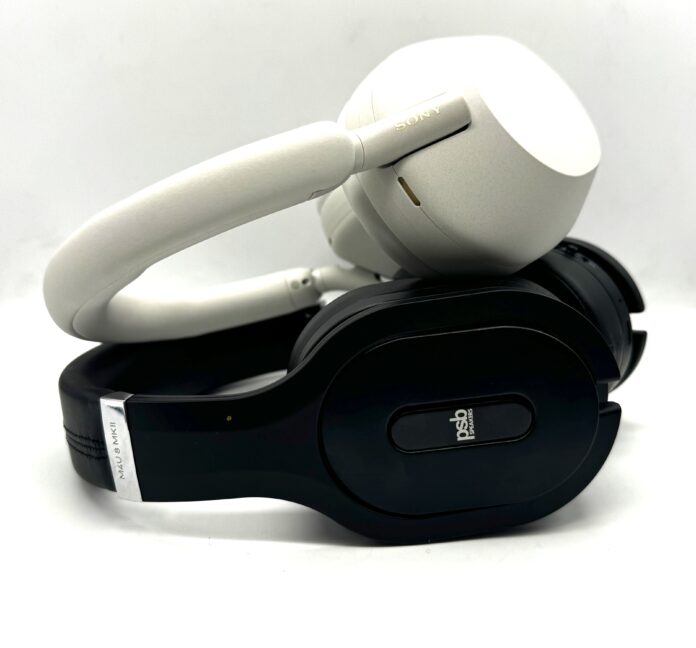We recently reviewed the PSB M4U8 MkII headphones and were quite impressed with their performance. These headphones, priced around $350, offer an audio experience that rivals the best in this range. We decided to compare them to another top contender, the Sony WH-1000XM5. Both models have their strengths and weaknesses, and our goal is to help you determine which might be the better option for you. Let’s dive in.
What You Get
| Sony WH-1000XM5: | PSB M4U8 MkII: |
|
|
Sony’s offering is straightforward, while PSB includes a few additional accessories that might appeal to frequent travelers or those needing more versatile connectivity options.

Look and Feel
The PSB M4U8 MkII opts for a traditional, bulkier design. Its appearance doesn’t follow the sleek fashion trends of recent Bluetooth headphones. Instead, it prioritizes function over form with big switches for ANC, volume, playback controls, and Bluetooth. This design might seem cumbersome, but it’s highly practical. The gyro ear cups maximize comfort and sound quality, providing a great seal without feeling overly tight, unless worn for extended periods. This ensures that even during long listening sessions, the headphones remain comfortable and deliver consistent audio performance.
In contrast, the Sony WH-1000XM5 features a modern, sleek design that appeals to contemporary tastes. Sony went for a complete design overhaul for their 1000X series headphones on the XM5. With a sleek yoke design and a comfortable headband, Sony achieves a balance of style and durability. The XM5 employs fewer, more discrete buttons for power and toggling ambient mode/noise canceling mode. What sets the XM5 apart is its touch controls on the back of the ear cups, contributing to its stylish and less bulky appearance. This design choice allows the headphones to appear more sophisticated and streamlined.

Design and Functionality
Driving the sound of the M4U8 MkII is a 40mm dynamic driver within an ABS + Polycarbonate housing. Using this driver and “RoomFeel” technology, the PSB headphones aim to mimic high-quality speakers set up in a good-sounding room. This unique approach to sound design provides a rich and immersive audio experience. The M4U8 MkII also includes ANC, which can drive itself to loud, if not excessive levels. While the ANC performance is not the strongest in its class, it gets the job done for most environments. The PSB companion app offers EQ controls and a sound personalization test, allowing users to tailor the performance to their ears.
The XM5 retains the popular design and functionality features you’re used to from the Sony ecosystem. This includes ambient sound mode, multipoint connection, and top-notch adaptive ANC. The adaptive ANC adjusts based on your environment, significantly reducing ambient noise. The touch-sensitive controls and voice activation features enhance the user experience, though they do take a little getting used to. The XM5 is driven by a new 30mm driver with a thermoplastic polyurethane and carbon fiber dome, promising better ANC and sound performance, especially in high frequencies.

Bluetooth and Battery Life
The M4U8 MkII features robust Bluetooth connectivity, compatible with codecs like AAC and aptX HD. However, the battery life somewhat undermines the solid wireless features, maxing out at 25 hours with ANC off. This performance lags behind newer models, making it less competitive in terms of battery longevity.
The XM5, on the other hand, boasts an impressive 30-hour battery life with ANC turned on. This is a standout feature, especially for users who need long-lasting performance. In terms of wireless connectivity, the XM5 uses Bluetooth 5.2 and supports AAC, SBC, and LDAC. The inclusion of LDAC is welcome as it aims to provide higher quality audio. However, the lack of aptX compatibility might be a downside for some users.

Sound Quality
Soundstage and Imaging: The M4U8 MkII shines in imaging depth, providing a closed but immersive soundstage. Each sound element possesses dimension and presence, offering an intimate yet engulfing listening experience. The “RoomFeel” technology significantly enhances spatial accuracy, making it a highlight of the M4U8 MkII.
Sony’s 360 Reality Audio enhances the soundstage for supported tracks, offering an immersive experience. However, without spatial audio, the soundstage feels narrower. That said, the imaging is precise, making it easy to pinpoint sound elements within the mix. The XM5 provides a different but equally impressive auditory experience.
Low End: The M4U8 MkII offers balanced and textured bass, enhanced by sound personalization. The bass response is punchy without being exaggerated, adding warmth and depth without overwhelming other frequencies. This makes the PSB headphones appealing to audiophiles seeking quality over quantity in bass performance.
The XM5’s bass is powerful and gripping but can be boomy without EQ adjustments. However, there’s plenty of room for customization to reign it in. Compared to the M4U8 MkII, the bass is slower but louder with great impact. Bass enthusiasts might find the Sony headphones more satisfying in this regard.
Mids: The M4U8 MkII’s mids are detailed and well-defined, with clear vocals and a balanced sound. The midbass transition is smooth, allowing more space for the mids to breathe. This results in a Harman-like feel to the sound, providing an enjoyable listening experience without extensive EQ adjustments.
The XM5’s mids are clear but can be overshadowed by the bass. Male vocals sometimes lack prominence, but instruments and effects are well-balanced. The midrange is more transparent and textured than previous models, but compared to the M4U8 MkII, it doesn’t feel as sophisticated and well-tuned.
Top End: The M4U8 MkII’s highs are present with a nice sense of splash and sparkle. The treble is not overly bright but has a pleasant extension, topping off the frequency response nicely. The tuning of the M4U8 MkII is its greatest feature, offering a well-rounded sound that should be pleasing to audiophiles.
The XM5’s has improved highs compared to previous Sony iterations but aren’t as clear as the PSB’s. EQ adjustments can enhance the treble performance for a more suitable sound. While the highs on the Sony are good, they don’t quite match the refinement of the PSB headphones.

Final Thoughts
Overall, choosing between the Sony WH-1000XM5 and the PSB M4U8 MkII depends on your priorities. If you seek superior noise cancellation, long battery life, and a plethora of features, the Sony WH-1000XM5 is the better option. It offers a modern design, touch controls, and advanced adaptive ANC, making it a top choice for tech enthusiasts and frequent travelers.
However, if sound quality and personalization are your primary concerns, the PSB M4U8 MkII offers a compelling alternative. With its unique “RoomFeel” technology, balanced sound signature, and detailed mids, the M4U8 MkII is ideal for audiophiles seeking an immersive and customizable audio experience. While it might lack some of the advanced features of the Sony, its focus on delivering high-quality sound makes it a promising choice in its price range.
The PSB M4U8 MkII and Sony WH-1000XM5 are available at Audio46.
MAJORHIFI may receive commissions from retail offers.








